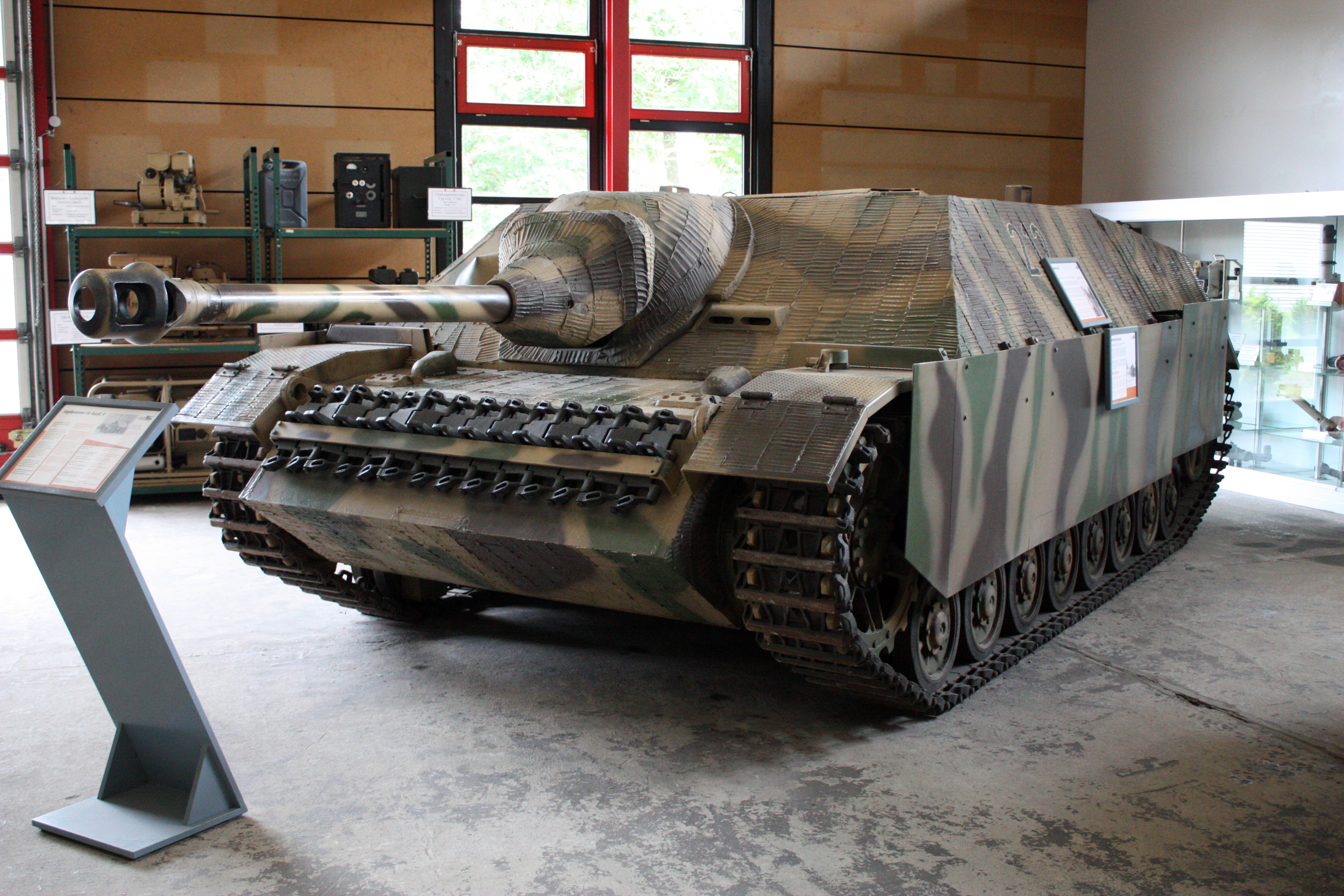Jagdpanzer on:
[Wikipedia]
[Google]
[Amazon]
 ''Jagdpanzer'' (JgPz) is the name given in
''Jagdpanzer'' (JgPz) is the name given in
German
German(s) may refer to:
* Germany (of or related to)
** Germania (historical use)
* Germans, citizens of Germany, people of German ancestry, or native speakers of the German language
** For citizens of Germany, see also German nationality law
**Ge ...
to a heavily-armoured, tracked tank destroyer, although it may also be used for other kinds of self-propelled guns. Literally translated from German, ''Jagdpanzer'' is "hunting tank".
It typically refers to anti-tank variants of existing tank chassis with a well-armoured casemate fixed superstructure, mounting an anti-tank gun with limited traverse in the front, and classed by the western Allies of World War II
The Allies, formally referred to as the United Nations from 1942, were an international military coalition formed during the Second World War (1939–1945) to oppose the Axis powers, led by Nazi Germany, Imperial Japan, and Fascist Italy ...
as a tank destroyer.
History
The ''Jagdpanzer'' designs followed on from the more lightly armoured ''Panzerjäger
''Panzerjäger'' ( German "armour-hunters" or "tank-hunters", abbreviated to ''Pz.Jg.'' in German) was a branch of service of the German Wehrmacht during the Second World War. It was an anti-tank arm-of-service that operated self-propelled ...
'' ("tank hunter") designs, which took an anti-tank gun and mounted it on top of a tank chassis with supplementary armour fitted around the gun crew. However, the armour had an open rear and top, almost never providing the crew with full protection from the elements. In addition, much experience was gained from the Sturmgeschütz series of assault guns for infantry support, which already used heavily armoured casemates, completely enclosing the vehicle's crew. Although they were associated with artillery and infantry support, they were often used in the anti-tank role.
Tactical use
On the battlefield, when the Germans had to retreat, their line of retreat would preferably pass the location of their anti-tank units, who would use their superior firepower to stop the enemy, perhaps even open the possibility of a counter-attack. Due to the lack of a turret and the armour being concentrated at the front, the ideal combat situation for ''Jagdpanzer'' units was in the planned ambush, and the skill of the commander of such units lay in correctly choosing and preparing such places long before needed.Types
The list below comprises all of the Jagdpanzer type tank destroyers made by Germany and otherAxis
An axis (plural ''axes'') is an imaginary line around which an object rotates or is symmetrical. Axis may also refer to:
Mathematics
* Axis of rotation: see rotation around a fixed axis
* Axis (mathematics), a designator for a Cartesian-coordinat ...
nations. That is, all of the Axis purpose-designed tank destroyers with fully enclosed casemate-style armor. The tank destroyers are sorted by the starting date of their production.
Post-war
After the war, the name ''Jagdpanzer'' was kept in use in the ''Bundeswehr
The ''Bundeswehr'' (, meaning literally: ''Federal Defence'') is the armed forces of the Federal Republic of Germany. The ''Bundeswehr'' is divided into a military part (armed forces or ''Streitkräfte'') and a civil part, the military part con ...
'' for a number of armoured vehicles used for anti-tank duties. This included the casemate-style ''Kanonenjagdpanzer
The Kanonenjagdpanzer (''KanJPz''; also known as Jagdpanzer Kanone 90mm, "tank destroyer, gun 90mm") was a West German Cold War tank destroyer. Its design was very similar to that of the World War II Jagdpanzer IV.
History
The first prototypes ...
'' carrying a 90 mm gun and the ''Raketenjagdpanzer Raketenjagdpanzer (missile armed tank hunter) is the designation of a range of German dedicated tank destroyers equipped with anti-tank guided missiles. Four different Raketenjagdpanzer have been used so far:
* Raketenjagdpanzer 1
* Raketenjagdpanz ...
s''. The first ''Raketenjagdpanzer'' was the ''Raketenjagdpanzer 1
The Raketenjagdpanzer 1 is an anti-tank guided missile-armed tank destroyer (the first such vehicle in service with the West German Armed Forces) that entered service in 1961. It was built on the chassis of the Hispano-Suiza HS.30, which was ...
'' built on the chassis of the ''SPz Lang'' HS.30 and armed with SS.11 missiles. The ''Raketenjagdpanzer 2
The Raketenjagdpanzer 2 or Raketenjagdpanzer SS-11 was a West German tank destroyer employed from 1967 to 1982 and equipped with Nord SS.11 guided anti tank missiles. It was developed at the same time as the Kanonenjagdpanzer and the Marder, and ...
'' was built on the same chassis as the ''Kanonenjagdpanzer'', but was equipped with two SS.11 launch-rails instead of carrying a gun.
Later, the ''Raketenjagdpanzer'' 2 and the ''Kanonenjagdpanzer'' were upgraded to Jaguar 1
The Raketenjagdpanzer (RakJPz 3) Jaguar 1 was a West German tank destroyer equipped with anti-tank guided missiles. From 1978 to 1982, 316 obsolete Raketenjagdpanzer 2 units were converted into Jaguar 1s by replacing the SS.11 missile system ...
and Jaguar 2
The Raketenjagdpanzer 4 Jaguar 2 was a West German tank destroyer equipped with anti-tank guided missiles. It was only operated by the Bundeswehr.
History
From 1983 to 1985, 162 Kanonenjagdpanzers were converted to ''Raketenjagdpanzer 4'' Jaguar ...
tank destroyers, armed with HOT or TOW
Towing is coupling two or more objects together so that they may be pulled by a designated power source or sources. The towing source may be a motorized land vehicle, vessel, animal, or human, and the load being anything that can be pulled. Th ...
missiles.
See also
* Tank destroyer * Assault gunNotes
{{reflist World War II tank destroyers of Germany de:Jagdpanzer ja:駆逐戦車 sr:Јагдтигар zh:驅逐戰車